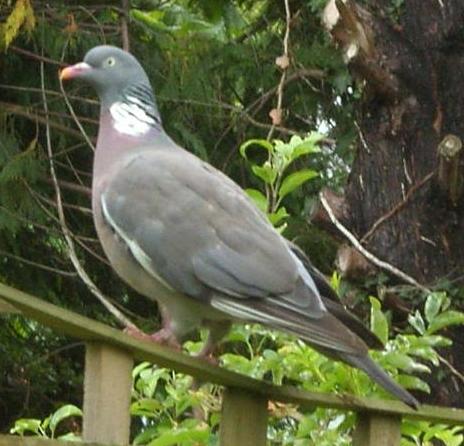Wood-pigeon
Scientific name: Columba palumbus
Family: Columbidae, Pigeons and doves.
 |
The Wood-pigeons are a pest to the gardener as they can devastate brassica crops, especially young plants. They tear the leaves to shreds, with only the fibrous skeletons left sticking up in the air. (The damage caused by Slugs and Caterpillars does not look as ragged.) On a larger scale they will also damage grain and pea crops, so are detested by farmers as well. They are mainly vegetarian eating flowers, young shoots, grasses, seeds and berries, but may eat invertebrates at times. Most of the damage to crops is done in the winter when continental migrants arrive to swell the numbers and they can be seen feeding in large flocks.
There are several species of pigeon in Britain, but the Wood-pigeon is the largest and most common. They can also be found in urban areas where they can be quite tame, but the Feral species more usually found in city centres is a descendant of the slightly smaller Rock Dove, Columba livia known to some as "rats with wings" due to the problems they can cause. This is the species that was domesticated to provide food centuries ago, but the Wood-pigeon is now the bird of choice for cooking. A lot of their bulk is in the feathers which actually weigh more than their skeletons.
The most distinguishing features are the white flashes on the neck and during flight a white bar across the wings becomes visible. The juvenile birds are browner and do not have the neck flashes.
When pairing, the display flight consists of flapping their wings noisily as they fly upwards quite steeply then gliding downwards. The nest is made from twigs, built by the male and female which also share the incubating of the smooth, white eggs. After hatching the squabs are attended to by both parents and are fed with a special 'milk' produced in their crop which is regurgitated.
Protect vulnerable crops like brassica with netting, but use a fine mesh to prevent the butterflies from laying their eggs, since other birds which would normally remove the caterpillars, will not be able to reach them. A tunnel made with Enviormesh or a similar product is ideal.
Back to GARDEN CREATURES
